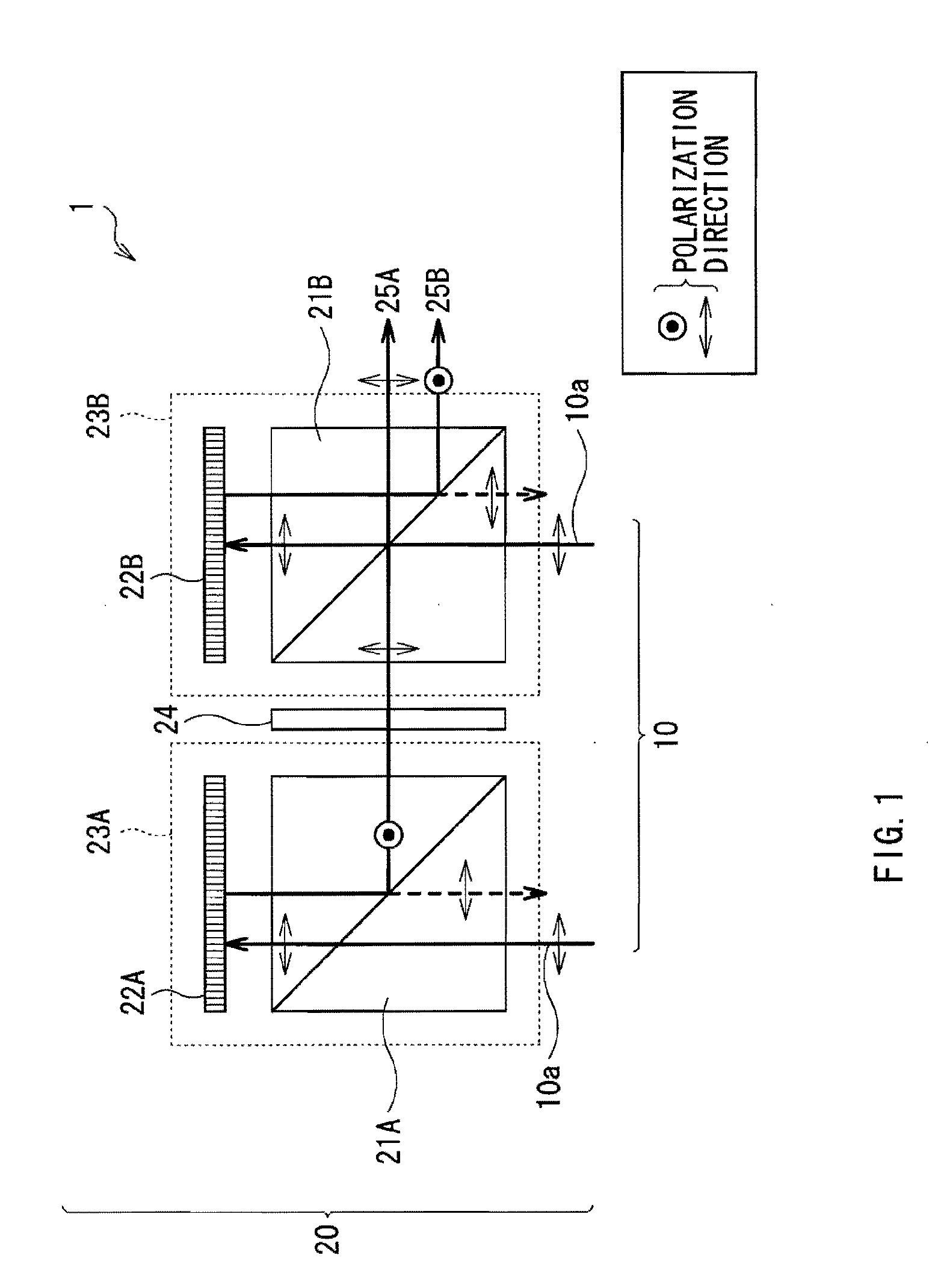Projection stereoscopic display
a stereoscopic display and projection technology, applied in the field of projection stereoscopic displays, can solve the problems achieve the effects of increasing the number of components and light loss, reducing power consumption, and high light condensing property
- Summary
- Abstract
- Description
- Claims
- Application Information
AI Technical Summary
Benefits of technology
Problems solved by technology
Method used
Image
Examples
first embodiment
[0022]FIG. 1 illustrates a configuration of a projection stereoscopic display (hereinafter referred to as stereoscopic display) 1 according to a first embodiment of the invention. The stereoscopic display 1 stereoscopically displays a picture based on an input picture signal supplied from outside, and roughly includes a light source 10 and a stereoscopic display optical system 20.
[0023]The light source 10 is a laser (a LD or a solid-state laser), and laser light 10a from the light source 10 includes, for example, a linearly polarized component (a first linearly polarized component) in a direction parallel to a paper plane (in a direction indicated by arrows in the drawing).
[0024]The stereoscopic display optical system 20 includes a first modulation section 23A which is configured of a first polarizing beam splitter 21A and a first reflective liquid crystal panel 22A, and a second modulation section 23B which is configured of a second polarizing beam splitter 21B and a second reflect...
application example 1
[0035]A stereoscopic display 2 illustrated in FIG. 2 has a configuration in which stereoscopic display optical systems 20 in the above-described stereoscopic display 1 are combined to allow color display of three primary colors R (red), G (green) and B (blue). In this case, reference numerals for components are denoted corresponding to the colors RGB such as, for example, stereoscopic display optical systems 20R, 20G and 20B. The stereoscopic display 2 includes the stereoscopic display optical systems 20R, 20G and 20B and a multiplexing prism 26 for combining pictures of these colors emitted from the stereoscopic display optical systems 20R, 20G and 20B.
[0036]In other words, in the stereoscopic display 2, as in the case of the above-described embodiment, the stereoscopic display optical system 20R into which red laser light 10aR has entered emits a red picture formed by superimposing right and left pictures. Likewise, the stereoscopic display optical system 20G into which green lase...
second embodiment
[0037]FIG. 3 illustrates a configuration of a stereoscopic display 3 according to a second embodiment of the invention. The stereoscopic display 3 has a configuration in which the first polarizing beam splitter 21A in the first embodiment is replaced with a wire grid polarizer 30, and the λ / 2 wave plate 24 is arranged in a position anterior to the wire grid polarizer 30. Other configurations, and functions and effects are the same as those in the above-described embodiment. Very thin metallic wires are formed on a surface of the wire grid polarizer 30 in a direction parallel to a paper plane, and the wire grid polarizer 30 allows light with a polarization direction perpendicular to the paper plane to pass therethrough, and reflects light with a polarization direction parallel to the paper plane.
[0038]In the embodiment, before the laser light 10a enters into the wire grid polarizer 30, the polarization direction of the laser light 10a is converted by the λ / 2 wave plate 24 so that the...
PUM
 Login to View More
Login to View More Abstract
Description
Claims
Application Information
 Login to View More
Login to View More - R&D
- Intellectual Property
- Life Sciences
- Materials
- Tech Scout
- Unparalleled Data Quality
- Higher Quality Content
- 60% Fewer Hallucinations
Browse by: Latest US Patents, China's latest patents, Technical Efficacy Thesaurus, Application Domain, Technology Topic, Popular Technical Reports.
© 2025 PatSnap. All rights reserved.Legal|Privacy policy|Modern Slavery Act Transparency Statement|Sitemap|About US| Contact US: help@patsnap.com



